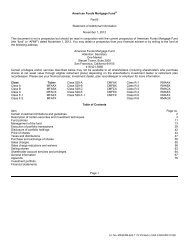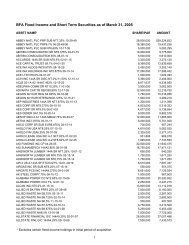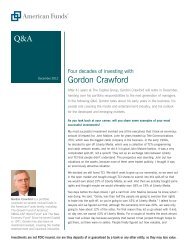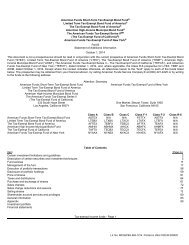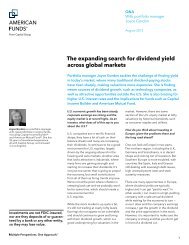Sung LeePortfolio managerMark DenningPortfolio managerDisruptive technology is having a huge impact onthe world. As investors, we have to make sure we areon top of all the change that is taking place, which iswhy having the proper resources in place is crucialin these industries.Mark Denning“The growth has been staggeringbecause of how the market operates;consumers have been trained to go therewhen they want to buy stuff online,” henotes. “Alibaba learned some lessonsfrom the battle between eBay andAmazon, and as a result has been able toavoid many of the traps that other onlinemarketplaces have fallen into.”Matt and several of the fund’s portfoliomanagers have invested in AlibabaGroup through Japanese conglomerateSoftBank, which owns 37% of theChinese internet company. When Mattstarted coverage of SoftBank in late2009, Alibaba was already a key part ofthe investment thesis — but its value hascontinued to increase since then. Thecompany is now preparing to go publicin the U.S. and its value is likely toincrease even more. “Alibaba is an evenbigger part of the thesis now, and I’mmore comfortable with it being at highervaluations,” Matt says after doing an indepthreview of SoftBank. “I understandthe business better and have a higherconviction in its long-term value.”Another Chinese internet company,Tencent, is also a large holding in thefund, even as managers remain sensitiveto valuation concerns. The companyoffers several popular services, suchas WeChat, as well as other forms ofentertainment like online games. Nicksays he was attracted to Tencent whenhe first began investing in disruptivetechnology, consulting with Hong Kong–based analyst Sugi Widjaja.“I soon realized that anything that could bedigitized would be big, so I worked withSugi to identify sectors and companiesimpacted by this digitization,” says Nick,who also consulted with Matt on Alibaba.“After working with our analysts, I beganto see a thread and invested more moneyas we identified these changes.”Several trends came together in Chinato allow a company like Tencent tothrive and become a disruptive force.As is often the case in developingcountries, technology acceleratesrapidly as consumers tend to adoptcertain trends more quickly than in thedeveloped world. For instance, manysmartphone users in China do far morewith their devices than those in theU.S. The penetration of sophisticatedsmartphone users combined withsuperfast networks created a veryconducive environment for companieslike Tencent and their wide offering ofentertainment and services.The key is figuring out how to monetizethese products, especially on mobiledevices. Sugi said his familiarity with asimilar company in South Korea gave himconfidence that Tencent would also besuccessful with its WeChat service. “Thechief financial officer of the Korean firmkept me up-to-date on the rate of usergrowth and engagement,” he says. “I wasamazed by how quickly the chat servicewas growing and then the companybegan to monetize that by offeringmobile games. I have a strong convictionthat Tencent will also be able to do this.”Sugi says this flexibility to meet withrelated companies in other countriesand industries is key to identifying trendsand taking a broader view, helping himmake the best long-term investmentdecisions for the fund. This includesmeeting with private companies as wellas venture capitalists, who are often firstto fund some of the start-ups focused ondisruptive technologies. “I keep in closecontact with them because things changewith technology in a matter of months andthey are seeing these companies everyday,” he says. “The more contacts we canmeet within both the public and privatesectors, the better investment decisionswe are able to make.”Mobile payments on the riseAnother important aspect of Alibaba’sand Tencent’s business models is theirmobile payment systems — knownas Alipay and Tenpay, respectively.They allow the companies to track keyconsumer data, which they can use toincrease customer loyalty. “The bigproblem with an online marketplace inChina was trust, because people didn’tknow who they were buying from,” saysMatt. “When Alibaba came up with apayment system that included an escrowservice, it was an important innovationin bridging that trust gap. Just as PayPalhelped enable eBay in the U.S., Alipay hasdone the same with Alibaba in China.”Alipay and Tenpay are becoming so largein China that they potentially could disruptsome of the country’s banks and paymentnetworks. This is in part because the online8 <strong>EuroPacific</strong> <strong>Growth</strong> <strong>Fund</strong>
Analyst focusPrimark reshapingEuropean retailLara PelliniInvestment analystNo industry has been impacted more by disruptive companiesthan retail. While much of this disruption has come from theincrease in e-commerce and mobile payments, one brick-andmortarretailer is still shaking up the industry: Primark, a divisionof Associated British Foods that’s quickly become one of themost popular clothing stores in Europe.London-based analyst Lara Pellini, who’s been with CapitalGroup for 12 years, recently spent the day visiting localmanagement at Primark’s first store in Berlin. It has 11 stores inGermany, with a second opening in Berlin this summer. If the firstis any indication, the next one should do just fine. “Customers arewilling to drive three or four hours to come to the store and evenfarther during holidays, when they come from Poland,” says Lara,noting that the Berlin store achieved record sales of €600,000on its first day. “Pent-up demand has been huge. Primark has thepotential to triple its store count, mostly in mainland Europe.”When you think aboutinvesting in mobilepayments, it basicallycomes down to a companythat can enable security,regardless of which systemis being used.Johnny ChanInvestment analystPrimark has been successful at a time when e-commerce isdisrupting the retail industry because it is one of the only brickand-mortarstores whose profit margins are tight enough toremain competitive. “The clothing market is highly fragmentedand retailers generally command higher margins than othercategories, such as grocery stores and home improvementretailers,” says Lara. “Primark runs a disruptive business modelbased on low margins and overhead coupled with high salesdensities. This is why others can’t match its low prices.”Lara is a firm believer in firsthand observation when it comes toevaluating companies she covers, especially when they’re takinga different approach like Primark. “I visit stores and observecustomers’ reactions to better understand what makes it sounique, and in some cases disruptive,” says Lara. “It didn’t takeme long to realize that Primark’s business model of selling themost fashionable items at the lowest prices would be difficultto replicate.” She also had to consider the implications for someincumbent retailers, who were not able to sell items at full pricebecause customers perceived them as being too expensive.<strong>EuroPacific</strong> <strong>Growth</strong> <strong>Fund</strong> 9




